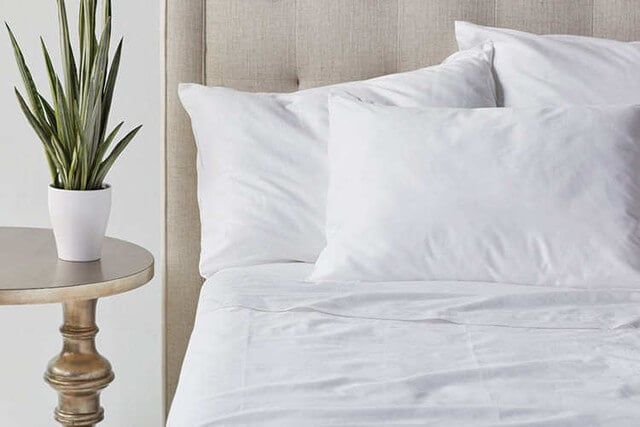There a variety of different thread counts when it comes to sheets, and understanding the difference of each will allow you to know which ones are best for what you’re looking for! Direct Textile Store offers a variety of different sheets to choose from, including different thread, sizes, colors, and cases. Below we will explore the meaning of thread and how to choose the best one.
What does Thread Count Mean?
Thread count means the density of threads woven into a square inch of fabric in textiles such as bed sheets, pillowcases, and duvet covers. It is often used to measure the quality and perceived luxury of linens.
Thread count refers to the total number of vertical (warp) and horizontal (weft) threads woven together within a square inch of fabric. This count includes both the number of threads running lengthwise (warp) and the number running widthwise (weft) in the fabric construction. Thread is typically expressed as a numerical value, with higher numbers indicating a greater density of threads and potentially finer fabric.
There is a common misconception that a higher thread always equates to better quality and comfort. While a higher thread can indicate a denser weave and smoother texture, it does not necessarily guarantee superior softness or durability. Other factors such as fiber quality, fabric type, and weave pattern also influence the overall feel and performance of the fabric. Therefore, it's essential to consider thread alongside these factors when evaluating the quality of textiles.
The Role of Fabric and Weave
The type of fiber used in the fabric significantly impacts its thread and overall characteristics. Natural fibers such as cotton, linen, and silk are commonly used in luxury linens and can achieve higher thread counts due to their finer, more pliable nature. Synthetic fibers such as polyester may have lower thread counts but can still offer durability and softness when woven into high-quality fabrics.
The weave pattern of the fabric affects its thread and texture. Common weave patterns include percale, sateen, and twill, each with its unique characteristics.
Percale weave features a simple over-under pattern, resulting in a crisp, matte finish and typically lower thread.
Sateen weave has a more complex over-under pattern that creates a smooth, lustrous surface and can accommodate higher thread.
Twill weave produces a diagonal pattern and is often used in fabrics with medium to high thread.
Comfort Factors Beyond Thread Count
While thread can contribute to the overall feel and perceived quality of the fabric, it is not the sole determinant of comfort. Factors such as fabric type, weave pattern, and finishing treatments also play a crucial role in determining the softness, breathability, and moisture-wicking properties of the fabric.
A well-balanced combination of these factors is essential to creating linens that offer both comfort and durability for a restful night's sleep.
When selecting bed linens, it's essential to consider personal preferences and priorities. While higher thread counts are often associated with luxury, they may not be suitable for everyone. Some individuals prefer the crisp, lightweight feel of lower thread percale sheets, while others prefer the silky-smooth texture of higher thread sateen sheets.
Ultimately, the best thread is the one that meets your specific needs and preferences for comfort, durability, and style. Below is a chart of thread counts and their characteristics:
| Thread Count Range | Characteristics |
|---|---|
| 100 - 200 |
|
| 200 - 400 |
|
| 400 - 600 |
|
| 600+ |
|
What Fabric is 180 Thread Count?
180 thread count sheets means there are 90 vertical threads (warp threads) and 90 horizontal threads (weft threads) in every square inch of the fabric. While 180 thread count sheets are available in various fabrics, they are commonly found in cotton blends or microfiber.
Thread Count in Hotel Sheets
The thread of typical hotel sheets can vary depending on the hotel's standards and budget. However, many mid-range to luxury hotels often opt for sheets with a thread ranging from 200 to 600. These thread counts strike a balance between quality, durability, and affordability, providing guests with comfortable and inviting bedding.
Common Thread Count Range: 200-300
Hotel sheets with a thread of around 200 to 300 are considered to be of good quality and offer a soft and smooth feel against the skin. They are often made from cotton or cotton-polyester blends and are suitable for everyday use in hotel rooms.
Higher-End Hotels Use 400-600 Thread Count
In upscale hotels or boutique establishments, you might find sheets with higher thread counts ranging from 400 to 600. These sheets are crafted from finer, long-staple cotton fibers or luxurious materials like Egyptian cotton or sateen. The higher thread results in a denser weave, creating a silky-smooth texture and a more luxurious feel.
Thread Count Isn’t Everything
While thread is a factor in determining the quality of hotel sheets, it's essential to consider other factors such as fabric type, weave pattern, and finishing treatments. Hoteliers prioritize linens that are durable, easy to maintain, and provide guests with a comfortable and restful sleep experience.
The thread of hotel sheets is chosen based on the hotel's brand standards, guest expectations, and budget considerations. Whether it's a mid-range hotel with sheets in the 200 to 300 thread range or a luxury hotel offering sheets with a thread of 400 to 600, the goal is to provide guests with high-quality bedding that enhances their overall stay experience.
Are Hotel Sheets 100% Cotton?
Many luxury hotels use sheets that are 100% cotton or a cotton blend due to their softness and breathability. Cotton is a natural fiber known for its ability to regulate temperature, wick away moisture, and provide a comfortable sleeping experience. However, not all hotel sheets are made exclusively from cotton.
In recent years, microfiber sheets have gained popularity in the hospitality industry. Microfiber is a synthetic material made from finely woven polyester fibers. It offers benefits like wrinkle resistance, durability, and a silky feel. Some hotels opt for microfiber sheets as they can be more cost-effective and require less maintenance compared to traditional cotton sheets.
While 100% cotton sheets remain a popular choice for their luxurious texture and natural properties, the choice between cotton and microfiber ultimately depends on the hotel's preference and the guest's experience they aim to provide.
Is 180 Thread Count Soft Enough?
The softness of 180 thread count sheets isn't always determined by thread. While a higher thread can indicate a smoother fabric, it's not the only factor that contributes to softness. Fabric type, weave, and finishing processes all play a role in how a sheet feels against the skin.
180 thread count sheets can offer satisfactory softness, especially if it's made from high-quality materials like 100% cotton. However, if you're seeking an exceptionally luxurious feel, you might consider exploring sheets with higher thread. Keep in mind that personal preferences vary; some people enjoy the crispness of lower thread sheets, while others prefer the buttery softness of higher thread.
While t 180 sheets can be soft and comfortable, their feel depends on the type of fabric, weave, and overall quality. Wholesale sheet sets in bulk come in various qualities, with some using 100% cotton for its natural comfort, while others may opt for microfiber for its practical benefits. When choosing bedding, consider not only the thread but also the material and your personal preferences for the ultimate sleep experience. Direct Textile Store offers a variety of bulk hotel sheets and healthcare sheets to choose from at an everyday low cost!
About the Author
Haley Bridges, Marketing Assistant at Direct Textile Store
Haley Bridges has served as Marketing Assistant at Direct Textile Store, where she specializes in hospitality linens, uniforms, and bulk textile solutions. She works closely with hotels, restaurants, and healthcare facilities to match them with durable, high-quality products that balance both performance and value. Haley's expertise in textile sourcing and merchandising strategy helps businesses make confident purchasing decisions while staying ahead of industry trends.
If you need assistance, contact Direct Textile Store Customer Service at 800-615-58






